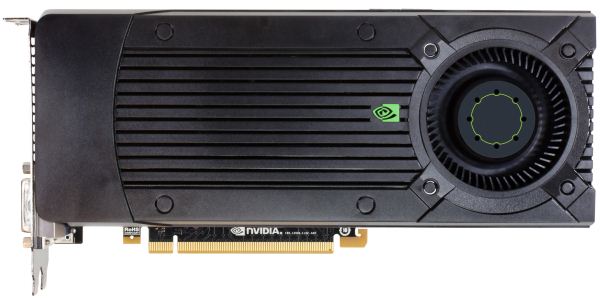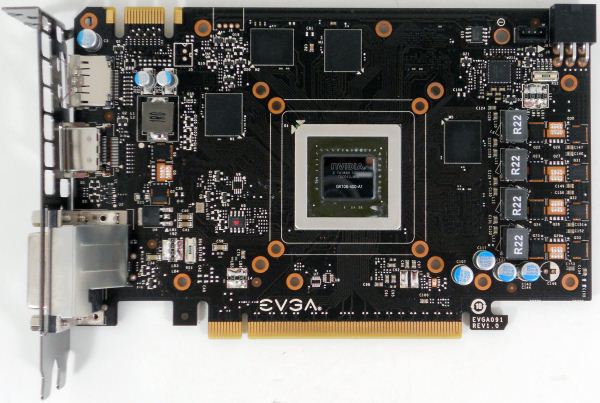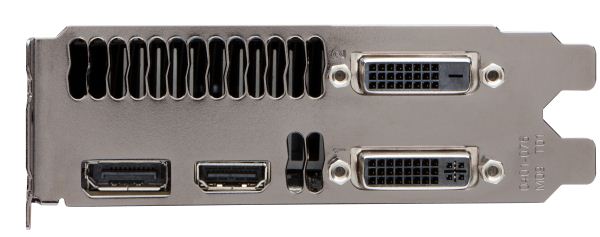The NVIDIA GeForce GTX 660 Review: GK106 Fills Out The Kepler Family
by Ryan Smith on September 13, 2012 9:00 AM ESTMeet The GeForce GTX 660
For virtual launches it’s often difficult for us to acquire reference clocked cards since NVIDIA doesn’t directly sample the press with reference cards, and today’s launch of the GeForce GTX 660 launch is one of those times. The problem stems from the fact that NVIDIA’s partners are hesitant to offer reference clocked cards to the press since they don’t want to lose to factory overclocked cards in benchmarks, which is an odd (but reasonable) concern.
For today’s launch we were able to get a reference clocked card, but in order to do so we had to agree not to show the card or name the partner who supplied the card. As it turns out this isn’t a big deal since the card we received is for all practical purposes identical to NVIDIA’s reference GTX 660, which NVIDIA has supplied pictures of. So let’s take a look at the “reference” GTX 660.
The reference GTX 660 is in many ways identical to the GTX 670, which comes as no great surprise given the similar size of their PCBs, which in turn allows NVIDIA to reuse the same cooler with little modification. Like the GTX 670, the reference GTX 660 is 9.5” long, with the PCB itself composing just 6.75” of that length while the blower and its housing composes the rest. The size of retail cards will vary between these two lengths as partners like EVGA will be implementing their own blowers similar to NVIDIA’s, while other partners like Zotac will be using open air coolers not much larger than the reference PCB itself.
Breaking open one of our factory overclocked GTX 660 (specifically, our EVGA 660 SC using the NV reference PCB), we can see that while the GTX 670 and GTX 660 are superficially similar on the outside, the PCB itself is quite different. The biggest change here is that while the 670 PCB made the unusual move of putting the VRM circuitry towards the front of the card, the GTX 660 PCB once more puts it on the far side. With the GTX 670 this was a design choice to get the GTX 670 PCB down to 6.75”, whereas with the GTX 660 it requires so little VRM circuitry in the first place that it’s no longer necessary to put that circuitry at the front of the card to find the necessary space.
Looking at the GK106 GPU itself, we can see that not only is the GPU smaller than GK104, but the entire GPU package itself has been reduced in size. Meanwhile, not that it has any functional difference, but GK106 is a bit more rectangular than GK104.
Moving on to the GTX 660’s RAM, we find something quite interesting. Up until now NVIDIA and their partners have regularly used Hynix 6GHz GDDR5 memory modules, with that specific RAM showing up on every GTX 680, GTX 670, and GTX 660 Ti we’ve tested. The GTX 660 meanwhile is the very first card we’ve seen that’s equipped with Samsung’s 6GHz GDDR5 memory modules, marking the first time we’ve seen non-Hynix memory on a GeForce GTX 600 card. Truth be told, though it has no technical implications we’ve seen so many Hynix equipped cards from both AMD and NVIDIA that it’s refreshing to see that there is in fact more than one GDDR5 supplier in the marketplace.
For the 2GB GTX 660, NVIDIA has outfit the card with 8 2Gb memory modules, 4 on the front and 4 on the rear. Oddly enough there aren’t any vacant RAM pads on the 2GB reference PCB, so it’s not entirely clear what partners are doing for their 3GB cards; presumably there’s a second reference PCB specifically built to house the 12 memory modules needed for 3GB cards.
Elsewhere we can find the GTX 660’s sole PCIe power socket on the rear of the card, responsible for supplying the other 75W the card needs. As for the front of the card, here we can find the card’s one SLI connector, which like previous generation mainstream video cards supports up to 2-way SLI.
Finally, looking at display connectivity we once more see the return of NVIDIA’s standard GTX 600 series display configuration. The reference GTX 660 is equipped with 1 DL-DVI-D port, 1 DL-DVI-I port, 1 full size HDMI 1.4 port, and 1 full size DisplayPort 1.2. Like GK104 and GK107, GK106 can drive up to 4 displays, meaning all 4 ports can be put into use simultaneously.














147 Comments
View All Comments
Jumangi - Thursday, September 13, 2012 - link
LOL way to try and spin AMD fanboy. The 660 is the equal of a 7870. It beats it in several tests and loses by a little in others. The $229 price is correct.Go qq somewhere else AMD dude.
Jamahl - Thursday, September 13, 2012 - link
Actually if you read anywhere else you'll find that the 7870 wins by 5-10% in the vast majority of cases.Samus - Thursday, September 13, 2012 - link
I'll take Anandtech reviews over any other reviews. This site has a 15 year reputation for truth.Jamahl - Thursday, September 13, 2012 - link
You do that. Most other people would take the average of all the reviews, and when they did that they'd realise that once again Anandtech is an outlier for Nvidia.rarson - Friday, September 14, 2012 - link
Anandtech lost that reputation years ago when everything started sounding pro-Intel/Nvidia/Apple.RussianSensation - Thursday, September 13, 2012 - link
Raghu78 is actually right."Overall the new ASUS GeForce GTX 660 DirectCU II seems to compete well with a price comparative factory overclocked Radeon HD 7870. While the gameplay experience is mostly the same between the two video cards, for the most part the factory overclocked Radeon HD 7870 seems to take the performance lead. If you look back at every game, the overclocked Radeon HD 7870 is on top in terms of raw performance,"
http://www.hardocp.com/article/2012/09/13/asus_gef...
Given that NV is 7 months late, all they did here was just barely match the price/performance of a 7 months old part. Hard to get excited about that when it's mid-September 2012 and HD8000 series isn't far off now.
HisDivineOrder - Friday, September 14, 2012 - link
Geforce 660 MSRP is $230. Radeon 7870 MSRP is $250. And if you're saying that the Geforce launch is unimpressive then you're probably ignoring the fact that AMD ignored price drops for the 78xx series cards for many, many months and only just when the info about the 660 and 660 Ti began to show up did they start aggressively lowering their pricing.So... what's impressive about nVidia's parts is that they brought competition which drove AMD to lower pricing so much you could today say there's nothing impressive about nVidia's pricing.
And that's what's impressive about it. You should be thanking nVidia for finally showing up to the competition.
Also, saying the "HD8000 series isn't far off now" is disingenuous if that line follows the same model as the 7000 series and staggers the launch so the low end comes midway through or at the end of 1Q 2013. We're not talking about the high end. We're talking about the mainstream variants.
And, if you truly believe your rhetoric, then AMD will price those parts as high or higher than the 78xx series showed up with in order to milk the market while nVidia's not able to keep up. So those cards again won't matter much since they won't be anywhere near the same price as these mid-$200 cards.
We don't even know if AMD won't milk this gen a while longer than they did prior generations because their strategy seems very different than the one they've used for quite a while. And with nVidia coming so late in this gen, AMD might see advantage in riding it out with parity and lower prices (while building up inventory of HD8k) to clean out their old stock.
Then one day after first quarter 2013, WHAM! HD8000 arrives in force. nVidia employees throughout the world look up from typing biased forum posts in every forum you visit and almost weep as cards in every bracket suddenly appear in the marketplace, but then a ray of hope shines through the darkness...
AMD priced everything high again. Angels sing and as Chuck Norris descends upon the clouds of awesomeness and badassness... GK110 arrives in his wake.
Ahhhh... I like this guessing game about what will happen with next gen thing.
raghu78 - Thursday, September 13, 2012 - link
buzz off . the majority of the reviews on the web show the HD 7870 to be faster.http://www.computerbase.de/artikel/grafikkarten/20...
http://ht4u.net/reviews/2012/nvidia_geforce_gtx_66...
http://www.hardware.fr/articles/876-21/recapitulat...
http://www.techpowerup.com/reviews/ASUS/GeForce_GT...
http://www.tomshardware.com/reviews/geforce-gtx-66...
http://www.hardocp.com/article/2012/09/13/asus_gef...
http://www.xbitlabs.com/articles/graphics/display/...
Margalus - Thursday, September 13, 2012 - link
I selected one random choice from your links, techpowerup. Guess what, the page you linked shows the 660 has higher performance per dollar than the 7870 at all resolutions except 2560x1600Galidou - Saturday, September 15, 2012 - link
Fun stuff, he said the ''majority'' and you look at only one of the links he sends. Replying the way you did is a little disrespectful. Next time just write: ''too long didn't read, this card ownz''.